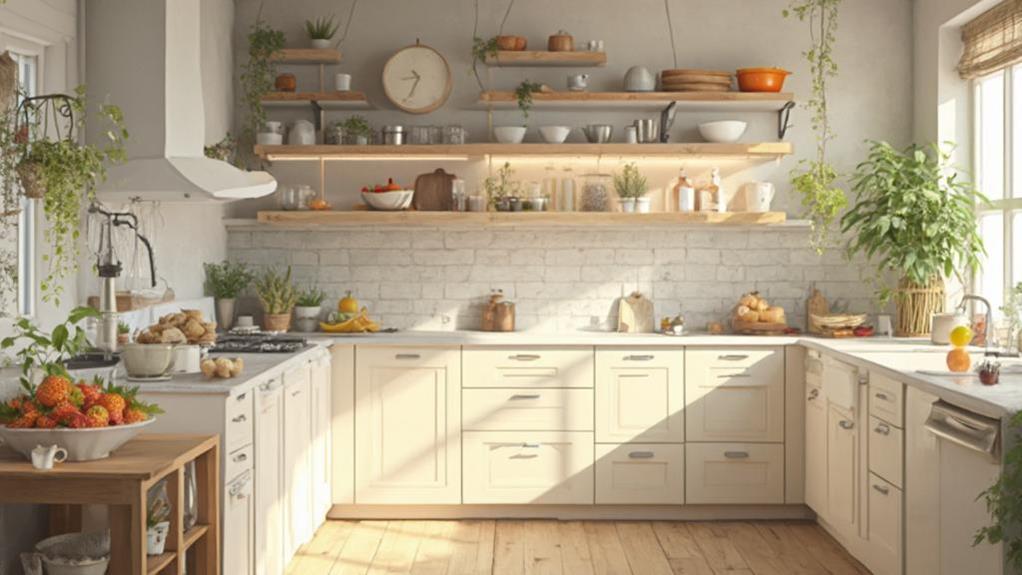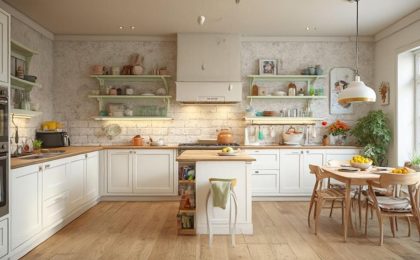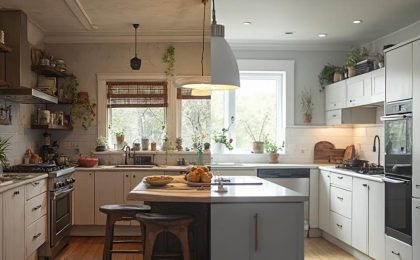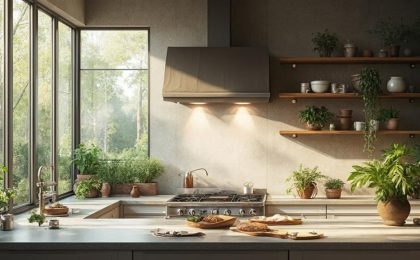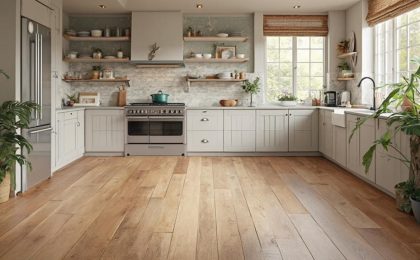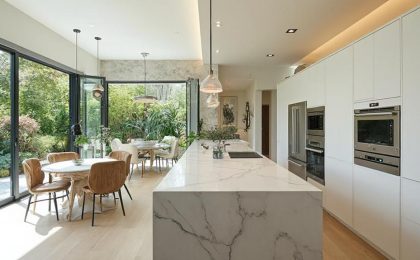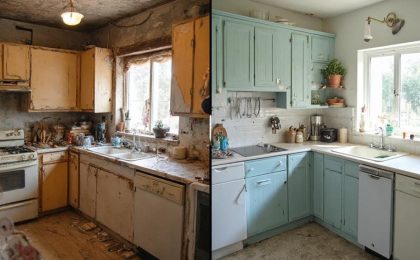When it comes to kitchen design, the colors you choose can dramatically influence both the look and feel of the space. You might think that selecting a palette is just about personal preference, but understanding color psychology is key to creating an environment that feels right for you. For example, certain colors can invigorate or calm, which could affect everything from meal prep to family gatherings. As you start considering your options, you'll want to explore how these choices can align with your kitchen's purpose and style. What will your perfect palette reveal about your culinary space?
Key insights
- Colors evoke emotional responses; choose hues that resonate with your desired kitchen atmosphere, such as tranquility or energy.
- Harmonious color schemes, like soft greens with warm neutrals, create a serene and inviting kitchen environment.
- Vibrant accents, such as colorful backsplashes or decor, can inject personality and energy into the kitchen design.
- Seasonal color trends can provide fresh inspiration, but balance trendy hues with timeless neutrals for longevity.
- Personalizing your palette reflects your individual style, enhancing the kitchen's functionality and visual appeal.
Understanding Color Psychology
When it comes to designing your kitchen, understanding color psychology can be a game changer. The colors you choose aren't just about aesthetics; they evoke emotional responses that can influence the mood of your space.
For instance, warm tones like red and orange can stimulate appetite and conversation, making them perfect for family gatherings. On the other hand, cool colors such as blue and green promote calmness and relaxation, ideal for a serene cooking environment.
Additionally, considering local design trends, such as kitchen renovation and design trends, can help you select a palette that not only reflects your style but also resonates with the overall aesthetics of Bradford homes.
Each hue carries its own color associations. Yellow, for example, is often linked to happiness and energy, brightening up any corner. White conveys cleanliness and simplicity, giving your kitchen a fresh, open feel.
By carefully selecting your palette, you not only enhance the visual appeal but also create an atmosphere that resonates with your lifestyle.
Imagine preparing a meal surrounded by colors that uplift your spirit or inspire creativity. Think about how certain shades can transform your kitchen from a mere cooking space into a vibrant hub of activity and comfort.
Ultimately, understanding color psychology allows you to tailor your kitchen to reflect your personal taste while also fostering the right emotional environment for you and your loved ones.
Popular Color Schemes
Color choices can greatly impact your kitchen's overall vibe, making it important to explore popular color schemes that resonate with contemporary design trends. Here are three standout options to contemplate:
1. Bold Contrasts: Imagine deep navy cabinets paired with crisp white countertops. This striking combination not only creates visual interest but also adds a sophisticated edge to your kitchen.
Bold contrasts can energize the space, making it feel dynamic and inviting. Additionally, working with local expertise in kitchen renovations can help you find the best materials and colors that align with your personal style.
2. Harmonious Blends: Soft greens and warm neutrals work beautifully together, creating an inviting, serene atmosphere.
This palette promotes relaxation and makes your kitchen feel like a cozy retreat, perfect for family gatherings and quiet meals alike.
3. Monochromatic Elegance: Using varying shades of a single color can add depth and sophistication.
For example, different tones of gray can give your kitchen a modern, sleek look. This scheme allows for subtle variations that keep the space interesting while maintaining a cohesive feel.
Choosing the Right Neutrals
A well-chosen neutral palette can transform your kitchen into a timeless space that feels both stylish and welcoming. When selecting your neutrals, think about the undertones; warm grays and soft beiges can create a cozy atmosphere, while cooler whites and light taupes evoke a fresh, airy vibe. The right balance of neutral undertones helps guarantee your kitchen looks cohesive and inviting.
Additionally, consider incorporating expert advice on tile selection to enhance your overall design with complementary textures and colors.
Don't just stick to flat colors—texture variations can elevate your design considerably. Incorporate elements like a matte finish on cabinets paired with glossy backsplashes, or mix in natural wood textures with stone countertops. This interplay of textures adds depth, making your neutral palette anything but boring.
You might also consider layering different shades of your chosen neutrals, creating a harmonious flow throughout the space. For instance, light gray walls can be complemented by darker gray cabinetry, while warm wooden accents bring warmth and character.
Adding Vibrant Accents
Incorporating vibrant accents into your kitchen design can inject energy and personality into the space, making it truly your own.
Whether you want to make a statement or add a touch of whimsy, bold color choices and playful patterns can transform an ordinary kitchen into an extraordinary one.
Consider these three ideas to enhance your kitchen with vibrant accents:
1. Colorful Backsplash: A striking backsplash in bright hues or intricate patterns can serve as the focal point of your kitchen.
Choose tiles that reflect your personality while harmonizing with your overall palette.
2. Dynamic Accessories: Introduce colorful kitchen accessories like dish towels, pots, and even small appliances.
These items can easily be swapped out, allowing you to refresh the look without a complete renovation.
3. Artful Decor: Hang vibrant artwork or display colorful dishes on open shelves.
This not only adds visual interest but also showcases your style and love for creativity.
Color and Kitchen Layout
When it comes to designing a kitchen, the interplay between color and layout can create a harmonious environment that enhances both functionality and aesthetics. Achieving layout harmony involves ensuring that your chosen colors flow naturally throughout the space. The right palette can visually connect different areas, making your kitchen feel cohesive and inviting.
Here's a simple guide to help you visualize how color can complement your kitchen layout:
| Color Choice | Effect on Layout |
|---|---|
| Light Neutrals | Expands space, creates openness |
| Warm Earth Tones | Adds warmth, enhances coziness |
| Bold, Dark Colors | Creates depth, adds drama |
| Soft Pastels | Softens edges, evokes tranquility |
| Bright Accents | Draws attention, highlights features |
Seasonal Color Trends
As you explore the perfect palette for your kitchen, seasonal color trends offer fresh inspiration that can breathe new life into your space.
Keeping an eye on color forecasting can help you choose seasonal palettes that reflect current design movements. Here are three trends to contemplate:
1. Earthy Tones: This season, rich browns and deep greens evoke a sense of warmth and connection to nature.
Incorporating these hues can create a cozy, inviting atmosphere that makes your kitchen feel like home.
2. Bold Accents: Vibrant colors like deep navy or emerald can serve as striking accents against neutral backgrounds.
These bold shades draw the eye and can be used for cabinetry or accessories, adding a touch of drama to your kitchen.
3. Soft Pastels: Light pastel shades, such as blush pink or soft lavender, are perfect for creating a calming, airy space.
These seasonal palettes can make your kitchen feel light and inviting, perfect for a cheerful cooking environment.
Personalizing Your Palette
When it comes to personalizing your kitchen color palette, understanding color psychology can transform your space into a reflection of your personality.
By incorporating your personal preferences alongside current trends, you can create a harmonious balance between the now and the timeless.
Let's explore how to make your kitchen uniquely yours while ensuring it remains inviting and functional.
Understanding Color Psychology
Colors can greatly influence your mood and overall experience in a space, making understanding color psychology essential for personalizing your kitchen palette.
By grasping the emotional effects of different colors, you can create a kitchen that resonates with your personal style while fostering the right atmosphere.
Here are three key color meanings to reflect on:
- Blue: Often associated with calmness and serenity, blue can evoke feelings of tranquility, making it a great choice for a peaceful culinary space.
- Yellow: This vibrant hue symbolizes happiness and energy. Using yellow can stimulate appetite and encourage lively conversations, perfect for a gathering space.
- Green: Representing nature and balance, green can instill a sense of harmony. It's invigorating and revitalizing, which can enhance your cooking experience.
Incorporating Personal Preferences
Creating a kitchen that truly reflects your personality requires a thoughtful blend of your favorite colors and practical design elements.
Start by considering color symbolism; each hue can evoke different feelings and associations. For instance, blue often represents tranquility, while yellow can bring warmth and cheerfulness. Think about how these colors resonate with your emotional connections and daily life.
As you choose your palette, don't shy away from incorporating bold accent colors that showcase your individuality.
If you love vibrant reds or calming greens, use them in cabinetry, backsplashes, or decor. This personalization not only creates a space you'll love but also fosters an environment that inspires creativity and comfort.
Balancing Trends and Timelessness
Steering the delicate balance between current design trends and enduring styles can elevate your kitchen's aesthetic while ensuring it remains relevant for years to come.
To achieve this, consider the following strategies:
- Choose Classic Base Colors: Opt for neutrals like white, gray, or beige as your foundation. These colors offer durability and versatility, allowing you to seamlessly integrate trendy accents without overwhelming the space.
- Incorporate Trendy Accents: Use bold hues or patterns in smaller areas, such as backsplashes or accessories. This creates dynamic color shifts that keep your kitchen fresh and exciting while maintaining a timeless backdrop.
- Focus on Quality Materials: Select paint and finishes known for their color durability. High-quality materials resist fading and wear, prolonging the life of your color choices and preserving your kitchen's aesthetic integrity.
Frequently Asked Questions
How Does Lighting Affect My Kitchen Color Choices?
Lighting plays an essential role in your kitchen color choices. Natural light can enhance hues, while artificial light, with its varying color temperatures, can alter how you perceive shades.
Consider your room's orientation; north-facing kitchens might need warmer tones to combat cool lighting. Reflective surfaces can amplify light and brighten colors, but beware of color fading over time.
Seasonal changes also affect light quality, influencing your mood and the overall ambiance of your kitchen.
Can I Mix Multiple Color Schemes in One Kitchen?
Yes, you can mix multiple color schemes in one kitchen!
To achieve color harmony, choose a dominant color and complement it with different hues. This creates design balance, ensuring the space feels cohesive rather than chaotic.
For instance, pair a bold cabinetry color with softer wall shades. Use accents like rugs or dishware to tie everything together.
With careful selection, your kitchen can reflect your unique style while remaining visually appealing.
What Are the Best Colors for Small Kitchens?
When you're choosing colors for a small kitchen, lighter shades like whites, pastels, and soft grays can really boost space optimization.
These hues create an illusion of openness, making your kitchen feel larger.
Don't forget about color psychology—blues and greens can evoke calmness, while yellows add warmth and energy.
Incorporating a pop of color through accessories can add personality without overwhelming your space.
Choose wisely, and enjoy a vibrant yet spacious kitchen!
How Often Should I Update My Kitchen Color Palette?
You should consider updating your kitchen color palette every 5 to 7 years, but don't shy away from seasonal trends if they inspire you.
Color psychology suggests that certain hues can influence your mood and energy, so refresh your space to keep it vibrant.
A new coat of paint or trendy accents can breathe life into your kitchen.
Stay in tune with your preferences, and let your kitchen reflect your evolving style.
Are There Colors to Avoid in High-Traffic Kitchens?
In high-traffic kitchens, it's wise to avoid light colors, especially whites and pastels, as they're prone to stains and dirt.
Instead, consider deeper shades that hide wear and tear.
Color psychology suggests that warm tones can create a welcoming atmosphere, while cooler shades might seem sterile.
Prioritize stain-resistant materials in your color choices, ensuring your kitchen remains both stylish and practical, allowing you to enjoy cooking without constant worry about wear.
Summary
In the vibrant world of kitchen design, the colors you choose can transform your space into a haven of creativity and comfort. By understanding color psychology and selecting the right hues, you'll not only enhance the kitchen's functionality but also infuse it with your unique style. Embrace the art of color, play with accents, and let your palette reflect your personality. Ultimately, your kitchen will become a warm, inviting space where culinary adventures and cherished memories unfold.
